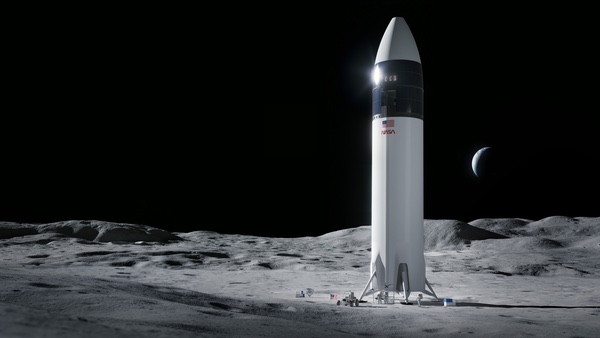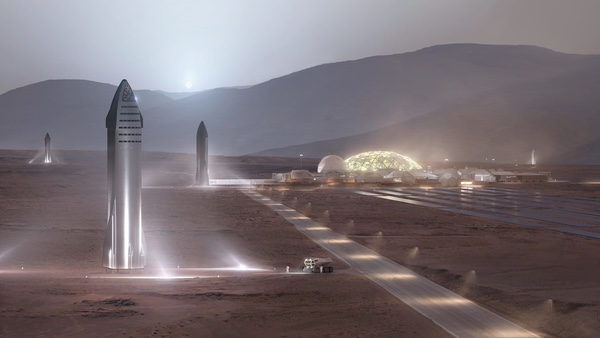With Starship, NASA is buying the Moon, but investing in Marsby Casey Dreier and Jason Davis
|
| SpaceX’s Starship is designed to be much more than a lunar lander: it’s actually an end-to-end transport system designed to ferry people to Mars. |
Starship is a Mars ship. By choosing Starship for the Moon, NASA is investing in the Starship program itself, providing SpaceX with a cash infusion for the same technology and systems it needs to get to the Red Planet—a true “Moon-to-Mars” strategy if there ever was one.
If Starship succeeds in returning humans to the lunar surface, it will be the ultimate vindication of the public-private partnership model first pioneered with NASA’s commercial cargo and crew resupply programs. NASA will gain a lunar lander at a fraction of the cost of the Apollo-era Lunar Module, and SpaceX—a private entity—would gain independent access to the lunar surface, a locale previously the domain of a single nation.
And in the same fell swoop, both organizations would step toward Mars.
Implications for SLS and Orion
SpaceX’s Starship is designed to be much more than a lunar lander: it’s actually an end-to-end transport system designed to ferry people to Mars. The vehicle launches and lands upright, similar to the way the company’s Falcon 9 boosters return to Earth for reuse.
Starship exists independently from NASA. SpaceX has been working on it for years, building prototypes and destroying them at a rapid pace as they perfect the vehicle’s ability to land upright.
But despite Starship’s planned ability to launch humans directly from Earth to the Moon or Mars, that’s not how NASA will initially use it.
For Artemis, Starship will blast off without a crew to lunar orbit. NASA astronauts will launch aboard Orion and the Space Launch System and then either directly dock with Starship or transfer to it via the Gateway. A crew will take Starship to the surface, stay for about a week, and then launch back to lunar orbit, where they will transfer back to Orion for return to Earth.
In theory, if SpaceX’s Starship can land on the Moon, it can ferry humans there as well. There’s no need for the Space Launch System and Orion at all.
In theory. But NASA’s not ready to say goodbye to those vehicles yet, and with good reason.
| Artemis comprises both classic cost-plus contracts and new fixed-price contracts for its major components, with jobs distributed around the country. It is the inevitable outcome for a large project that depends on discretionary spending overseen by a representational political system. |
First, the technical side: While SpaceX has shown that it can reliably land the booster stage of its Falcon 9 rocket upright (although one occasionally misses the mark), the spent booster stage doesn’t currently land with a heavy, pressurized crew compartment on top of it.
Starship, meanwhile, is an order of magnitude larger than the Falcon 9, and is still trying to perfect its landing on Earth. Its booster, the Super Heavy, has yet to fly. NASA is not yet ready to launch its astronauts on such a new system, though that could change over time.
Additionally, vehicles returning to Earth from the Moon hit the atmosphere at much higher speeds than they do when returning from Earth orbit. NASA’s Orion crew capsule, which uses legacy heat shield technology that dates back to the Apollo program, successfully tested a high-speed reentry during its 2014 test flight. The gargantuan Starship vehicle will belly-flop through the atmosphere, taking a page out of the Space Shuttle’s playbook. Starship has yet to successfully land from Earth orbit, let alone lunar orbit.
That brings us to the second reason: politics.
SLS and Orion were written into US law by the Senate in the 2010 NASA authorization bill and employ tens of thousands of people in every state. Congressional support for the projects has remained strong over the years, even as the projects have delayed their schedules and blown their original budget projections. By merely flirting with non-SLS options for sending humans to the Moon, as former NASA Administrator Jim Bridenstine did two years ago, the agency incited the wrath of powerful senators.
The current plan for Artemis is thus an artful mix of political and technological compromises. Every major NASA contractor participates in the program, as will the agency’s major international partners through the Gateway program. Artemis comprises both classic cost-plus contracts and new fixed-price contracts for its major components, with jobs distributed around the country. It is the inevitable outcome for a large project that depends on discretionary spending overseen by a representational political system.
 The version of Starship that NASA will use to send astronauts to the Moon later this decade. (credit: SpaceX) |
Moon to Mars
Despite the current focus on the Moon, NASA’s public relations materials constantly remind us that Mars has not been forgotten. Artemis is a “Moon to Mars” program, though up until this announcement the Mars part of that claim was more ambition than reality.
The Moon and Mars represent markedly different environments and challenges. The Moon is far closer to Earth, allowing astronauts to stay in what is basically real-time communication with the ground. They can return home in a matter of days if something goes wrong. There are launch opportunities roughly every month.
Mars offers no such conveniences. Communications are delayed by tens of minutes, requiring significant increases in spacecraft autonomy. Launch windows are limited to once every two years when Earth and Mars are optimally aligned. Landing on Mars, with its thin atmosphere and significant gravitational well, is a far harder problem than landing on the Moon’s airless expanse.
| So, by choosing Starship, NASA is gaining a partner with shared long-term goals that is going to Mars regardless of domestic political uncertainties. And both sides will benefit. |
Nevertheless, the Moon (and, more broadly, cislunar space) can be useful for developing and testing the hardware and techniques needed to send humans to Mars. That is, if missions to the Moon are deliberately pursued with Mars in mind, it is all-too-tempting (and cheaper) for engineers to optimize for Moon-only solutions in a tight budgetary environment. As a consequence, the path from the Moon to Mars can easily dead end in a lunar cul-de-sac.
The landers proposed by Dynetics and Blue Origin’s National Team were lunar landers. They were designed solely for the Moon and for NASA’s lunar architecture of the Gateway miniature space station, Orion, and SLS. Perhaps they could be adapted for future needs at Mars, but judging by their public proposals, major modifications would be needed to do so.
SpaceX’s proposal, however, was unique in that Starship was not designed for the lunar environment, but will be adapted for it.
SpaceX is a new breed of aerospace company: one with ambitions beyond that of serving the whims of government. As a privately-held company, it is under near-total control by its founder, Elon Musk, who can pursue his agenda as long as it makes money. His agenda happens to be human settlements on Mars.
Whether this is a feasible (or even desirable) goal is beside the point. SpaceX has a highly-capable workforce. It is well-capitalized. And it is building a Mars ship with Starship, whether or not NASA chips in.
So, by choosing Starship, NASA is gaining a partner with shared long-term goals that is going to Mars regardless of domestic political uncertainties. And both sides will benefit. SpaceX will enjoy a significant cash infusion in Starship and will gain access to the lunar surface. NASA will save billions of dollars on a lunar lander while supporting a Mars initiative.
With Starship, NASA is buying the Moon, but it is investing in Mars.
Note: we are using a new commenting system, which may require you to create a new account.
